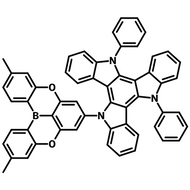MR-TADF Materials
Multiple Resonance Thermally Activated Delayed Fluorescence (MR-TADF) represents a breakthrough in light-emitting technology, combining the principles of thermally activated delayed fluorescence (TADF) with an innovative molecular design. This advanced mechanism enables MR-TADF materials to achieve up to 100% internal quantum efficiency (IQE) in OLED applications by efficiently utilizing both singlet (S1) and triplet (T1) excitons.
The term "Multiple Resonance (MR)" highlights the unique delocalization of electronic states within the molecule. By strategically positioning electron-deficient and electron-rich atoms in an ortho-configuration within the fused aromatic structure, MR-TADF materials achieve spatial separation of the highest occupied molecular orbital (HOMO) and lowest unoccupied molecular orbital (LUMO), while maintaining close energetic alignment. This distinctive design ensures:
Explore our MR-TADF materials, including DABNA-1 and its derivatives, to revolutionize your OLED designs with unmatched efficiency and precision.
Jump to: Browse all MR-TADF Materials | Resources and Support
Browse MR-TADF Materials
Resources and Support
 Multi-Resonance Thermally Activated Delayed Fluorescence (MR-TADF)
Multi-Resonance Thermally Activated Delayed Fluorescence (MR-TADF)
Multiple resonance thermally activated delayed fluorescence (MR-TADF) is a light emitting process engaging the same working principle as thermally activated delayed fluorescence (TADF).
Read more...Thermally Activated Delayed Fluorescence (TADF) is a mechanism by which triplet state electrons can be harvested to generate fluorescence.
Read more... Molecular Design Principles of MR-TADF Materials
Molecular Design Principles of MR-TADF Materials
The design of multiple resonance thermally activated delayed fluorescent (MR-TADF) materials requires careful selection of molecular scaffolds and substituents to achieve the desired photophysical properties i.e. color and color purity.
Read more... MR-TADF Applications
MR-TADF Applications
MR-TADF emitters show great application potential in high color purity and high-resolution organic light-emitting diode (OLED) displays, and their long emission lifetimes also make them ideal for use in bioimaging probes, fluorescent sensors, and phototheranostics.
Read more...An exciplex (or excited complex) is a complex formed from two different molecules, where one molecule is in an excited state (donor) and the other is in the ground state (acceptor). Both are typically conjugated semiconducting molecules. This short-lived complex will occur when the molecules are in close proximity to one another, and it results in a lower energy than if the two existed separately in their excited and ground states.
Read more...Triplet-triplet annihilation (TTA) is an energy transfer process where two molecules in their triplet excited state interact to produce two singlet states: one molecule transitions to its singlet excited state and one molecule transitions to its singlet ground state
Read more... TADF Exciplex OLED Technology
TADF Exciplex OLED Technology
A thermally activated delayed fluorescence (TADF) exciplex is an excited-state species that can exhibit thermally activated delayed fluorescence or transfer its energy to a lower-energy emitter. TADF exciplex is formed between electron-donating and electron-accepting molecules by intermolecular charge transfer.
Read more...






